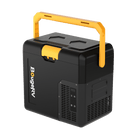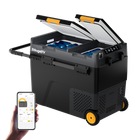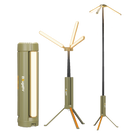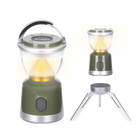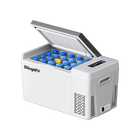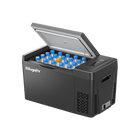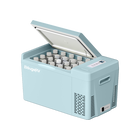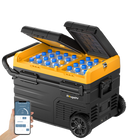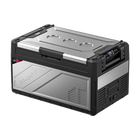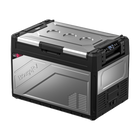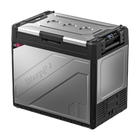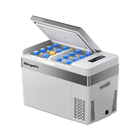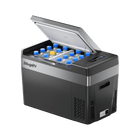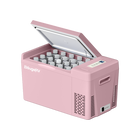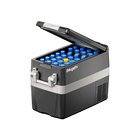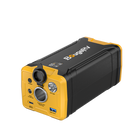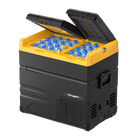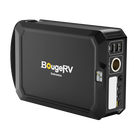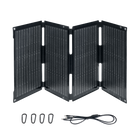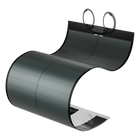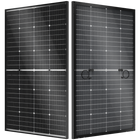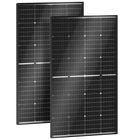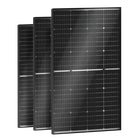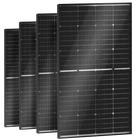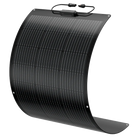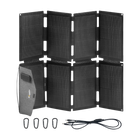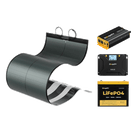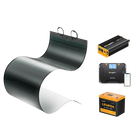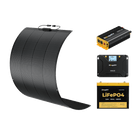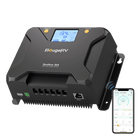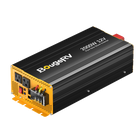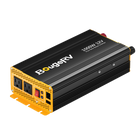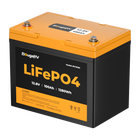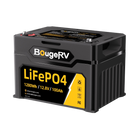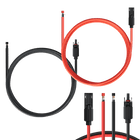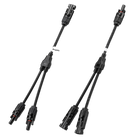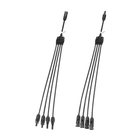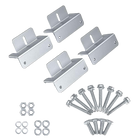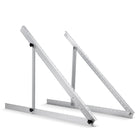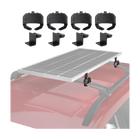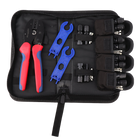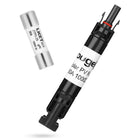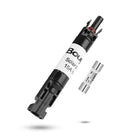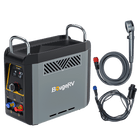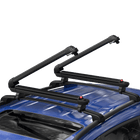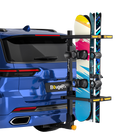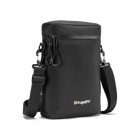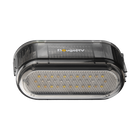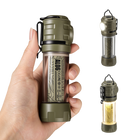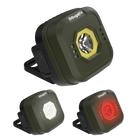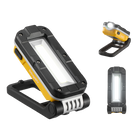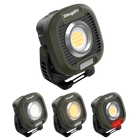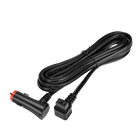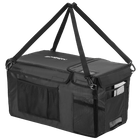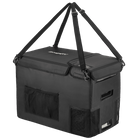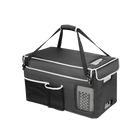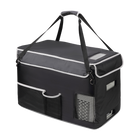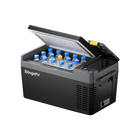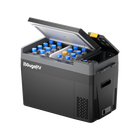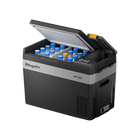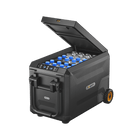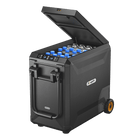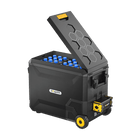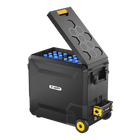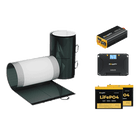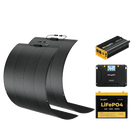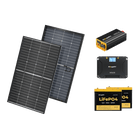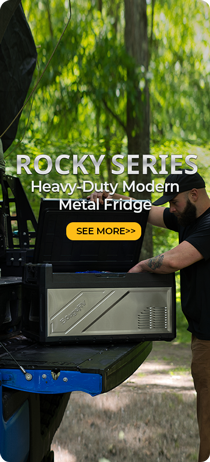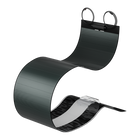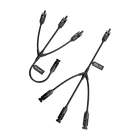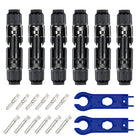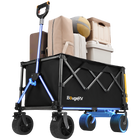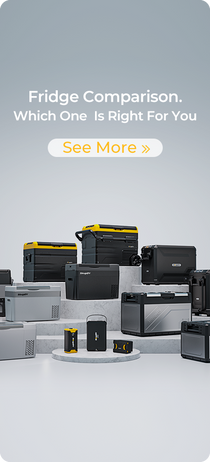The Ultimate Guide to an Off-Grid Solar Power System

In this comprehensive guide, we’ll cover everything you need to know— from understanding what an off-grid solar power system is to planning, installation steps, and maintenance tips. Whether you're a novice or an enthusiast, this guide will help you successfully build your off-grid solar power system for your home, RV, or camping needs, and optimize it for peak efficiency.
Let's dive in and start your journey toward energy independence!
What Is an Off-Grid Solar Power System?
An off-grid solar power system is designed to operate independently from the traditional electrical grid. This means all the electricity you use is generated on-site by solar panels, stored in batteries, and managed through various control systems. These systems include charge controllers, inverters, and monitoring tools. Together, they ensure efficient operation, protect components and provide real-time performance data for optimal management.
Unlike grid-tied systems that can send excess energy back to the grid, off-grid systems require careful planning and management to ensure you have enough power during different weather conditions and seasons.
How Do Off-Grid Solar Power Systems Work?
Off-grid solar systems generate electricity independently from the traditional electrical grid. Solar panels capture sunlight and convert it into direct current (DC) electricity. This electricity is stored in batteries through charge controllers, which regulate the energy flow to prevent overcharging.
Then, inverters convert the stored DC power into alternating current (AC) power, which standard household appliances can use. Monitoring systems track energy production and consumption, ensuring efficient operation and optimal performance.
Why Choose an Off-Grid Solar Power System?
There are several compelling reasons to choose an off-grid solar power system:
-
Energy Independence: With an off-grid solar power system, you no longer depend on utility companies for electricity. This independence can be particularly valuable in remote areas where grid access is unreliable or nonexistent.
-
Cost Savings: Although the initial investment can be high, off-grid solar power systems save money in the long run. After the upfront costs, the primary expenses will be maintenance and occasional replacements.
-
Reliability During Outages: Off-grid solar systems provide a reliable energy source even during grid outages. This is especially crucial in areas prone to natural disasters or frequent power interruptions.
-
Environmental Sustainability: Using solar power reduces your carbon footprint. By harnessing the sun's energy, you minimize reliance on fossil fuels and contribute to a greener planet.
📚 Know More: 7 Advantages Of Solar Energy
Key Components of an Off-Grid Solar Power System

Before diving into the setup process, it's important to understand the key components of an off-grid solar power system. These include solar panels, charge controllers, batteries, inverters, backup generators or portable power stations, solar connectors and cables, solar panel mounts and brackets, and system monitoring tools. Now, let's take a closer look at each one!
1. Solar Panels

Solar panels capture sunlight and convert it into electricity. There are several types available, such as
- Monocrystalline solar panels
- Thin-film solar panels
- Flexible solar panels
- Foldable solar panels
- Bifacial solar panels
- Polycrystalline solar panels
- Etc.
Each type has its own efficiency ratings and cost factors. Keep reading to learn more about their efficiencies in the "How to Choose a Solar Panel" section.
2. Charge Controller

A charge controller is essential for an off-grid solar power system. It manages the voltage and current from the solar panels to the batteries, preventing overcharging and extending battery life. There are two main types of solar charge controllers: Pulse Width Modulation (PWM) and Maximum Power Point Tracking (MPPT).
PWM controllers are more affordable and simpler, making them great for smaller systems. MPPT controllers are more efficient, especially in cold or cloudy conditions, but they do come with a higher upfront cost.
At BougeRV, you can easily find PWM and MPPT charge controllers to complete your off-grid solar power system.
3. Batteries

Batteries are crucial for an off-grid solar power system stored energy ensures you have a continuous power supply during nighttime or on cloudy days when solar generation isn't enough. Deep-cycle batteries, like lithium-ion batteries and lead-acid types, are commonly used in off-grid systems since they can be discharged and recharged multiple times.
📚 Read Blogs About Battery Types:
4. Inverter

An inverter is necessary for both RV and home off-grid solar power systems. It converts the DC electricity stored in your batteries into AC electricity, which is what most of your household appliances and devices use. Without an inverter, you wouldn't be able to use standard electrical equipment with your solar power system.
5. Backup Generator or Portable Power Station (Optional)

To boost reliability, some off-grid setups come with a backup generator or portable power station. These can be lifesavers during extended cloudy spells. A generator or power station offers peace of mind and a steady energy source when your solar panels and battery storage fall short. Adding the right backup generator ensures your off-grid system stays strong and reliable no matter what the weather throws at you.
6. Solar Connectors & Cables

Solar connectors and cables play a crucial role in off-grid solar power systems by linking together solar panels, charge controllers, inverters, and batteries. They make sure that the electricity generated from the sun is transmitted efficiently and safely. MC4 connectors are commonly used because they offer secure, waterproof connections.
When it comes to cables, PV (photovoltaic) cables are designed specifically for solar applications. They're UV-resistant and durable enough to handle outdoor conditions. The right connectors and cables are key to maximizing system performance, minimizing energy losses, and ensuring the long-term reliability of your off-grid solar power setup.
7. Solar Panel Mounts & Brackets (Optional)

If you’re using rigid solar panels, mounts and brackets are a must-have. They securely attach your solar panels, optimize their exposure to sunlight, and ensure they’re structurally stable. This is key for keeping your system efficient and ensuring it lasts a long time.
8. System Monitoring
Monitoring tools let you keep an eye on how your solar panels, batteries, and overall system are performing. You can do this with specialized software or hardware devices.
Planning Your Off-Grid Solar Power System
Before we can successfully install an off-grid solar power system, careful planning is essential. This involves understanding your energy needs, preparing components, and more. Here are the steps to follow:
1. Assess Your Energy Needs
Make a list of all the appliances and devices you'll be using, along with their wattage and estimated usage hours. By multiplying their wattage by the usage hours and adding them all up, you'll figure out how much power you need to generate and store.
If you don't want to do the math yourself, you can use free online solar power calculators like the BougeRV Off-Grid Solar Power Calculator to quickly estimate your home's or RV's kilowatt usage with just a few clicks.
📚 We also have a blog post titled "How Many kWh Does A House Use? Complete Guide!" to help you out!
2. Evaluate Your Location
The amount of sunlight your location receives directly impacts the efficiency of your solar panels. Use solar insolation maps or online tools to determine the average daily sunlight hours in your area. Generally, most parts of the U.S. get about 8 to 10 hours of daylight per day throughout the year and around 5-6 hours of peak sunlight. It's amazing how much this can change from season to season and place to place! For example, during the summer, areas like Arizona or California can get around 12 to 14 hours of daylight, while in the winter, states like Alaska might only receive a few hours of sunlight each day.
3. Size Your System
Once you know your energy needs and how much sunlight your location gets, you can calculate the size of your solar array and battery bank. It's a good idea to add a buffer to make sure you have enough power even during cloudy days or times of high usage. Learn More:
📚 Read Blogs about Sizing Solar Panels:
- How To Calculate Solar Panel Output?
- How Many Watts Does a Refrigerator Use?
- How Many Solar Panels Do I Need For 1000 kWh Per Month?
- What Size Solar Panel Do I Need to Run a 12V Fridge? (with Chart)
📚 Read Blogs about Sizing Battery Banks:
- Can A Portable Power Station Run A Refrigerator?
- Can a Portable Power Station Run a Sump Pump?
- Can A Portable Power Station Run A Space Heater?
- Can A Portable Power Station Run A Coffee Maker?
- What Size Generator To Run A 2000 Sq. Ft. House?
- Can You Run a Fridge off a Car Battery?
- Will an RV Fridge Run Off Battery While Driving?
- How Long Will a 100Ah Lithium Battery Run a 12V Fridge?
4. Choose the Right Components

Pick high-quality components that fit your system’s needs. Research different brands, read reviews, and consult experts if needed. We’ve prepared guidelines to help you choose the right parts, including solar panels, charge controllers, batteries, inverters, connectors & cables, and solar panel mounts & brackets. Check them out—they’ll clarify any tough decisions you need to make!
A. Choose the Perfect Solar Panels for Your Off-Grid Solar Power System
Here are some key factors to help you choose the ideal solar panels that meet your energy needs and budget, ensuring a successful and cost-effective solar power system:
- Energy Needs: Calculate your household’s annual energy consumption or RV energy usage to determine the size and number of panels you need. Also, consider future energy requirements if you plan to expand your system.
-
Solar Panels Types: Monocrystalline panels are highly efficient and sleek but can be more expensive. Polycrystalline panels are more affordable with slightly lower efficiency. Thin-film panels are flexible and lightweight, making them suitable for irregularly shaped roofs or curved RV rooftops, though they are generally less efficient than Monocrystalline solar panels.
- Efficiency: Opt for high-efficiency solar panels, as they produce more energy per square foot, which is great for limited roof space. Typically, solar panel efficiency ranges from 15-22%, but BougeRV solar panels can reach up to 25%.
- Durability: Look for panels with long warranties (usually 20-25 years) to ensure durability. If you live in an area with extreme weather conditions, check for weather-resistant features.
- Cost: Weigh the upfront costs against long-term savings on your electricity bills. Consider the cost-per-watt to compare different solar panel options.
- Brand Reputation: Choose well-established brands, BougeRV for example, known for quality, reliability, and excellent customer service. Read reviews and check ratings from trusted sources.
- Installation: Ensure the solar panels can be easily installed on your roof type, whether it’s flat, sloped, or unique. By the way, choose solar panels that are compatible with your existing electrical setup to avoid costly modifications.
- Local Climate: Select solar panels that can withstand high heat or cold temperatures. If you live in a cloudy area, consider thin-film CIGS solar panels for their good low-light performance.
📚 Read helpful BougeRV blogs to learn even more practical tips and valuable information to make solar panel selection easier!
|
Blogs About Solar Panel Types and Advantages |
|
|
Solar Panel Comparision Blogs |
|
|
Blogs About Solar Panel Efficiency |
|
|
Blogs About Solar Panel Wattage |
B. Choose a Charge Controller for an Off-Grid Solar Power System
Picking the right charge controller is key to protecting your batteries and getting the most out of your system. Besides selecting the right type, here are some other important factors to consider:
- Voltage compatibility. Ensure the charge controller matches the voltage of both your solar panels and battery bank—common options are 12V, 24V, and 48V systems. If you’re setting up a 12V solar system, make sure to use a charge controller rated for at least 12V.
- Current capacity. The controller should handle the maximum current your solar array can produce. It's a good idea to have a bit of extra capacity to allow for future expansions.
- Additional features: Look for features like temperature compensation and LCD displays for monitoring. Some advanced models even offer remote monitoring capabilities, which can be super convenient.
📚 Learn more information on choosing solar charge controllers:
C. Choose Batteries for an Off-Grid Solar Power System
- First off, think about the type of batteries you need. Lead-acid batteries are pretty common and budget-friendly but they do require regular maintenance and good ventilation. On the other hand, lithium-ion batteries might cost more upfront, but they last longer, are more efficient, and need a lot less upkeep.
- Next, consider the capacity and voltage of the batteries. Capacity, measured in amp-hours (Ah) or kilowatt-hours (kWh), indicates how much energy your battery can store. A higher capacity means more stored energy, which is crucial if you live in an area with lots of cloudy days. Also, make sure the battery voltage matches your 12V, 24V, or 48V system.
- Another important factor is cycle life. This tells you how many charge and discharge cycles the battery can go through before its capacity starts to drop. More cycles mean a longer-lasting battery.
- Finally, look at the manufacturer’s warranty and reliability ratings. Investing in high-quality batteries from well-known brands can save you a lot of trouble in the long run.
D. Choose the Right Inverter for Your Off-Grid Solar Power System
There are two main types of inverters: pure sine wave and modified sine wave. Pure sine wave inverters provide cleaner, more stable power that's compatible with all electronic devices. While they’re pricier, they’re generally worth it if you want to run sensitive electronics like computers or medical equipment. Modified sine wave inverters are cheaper but may not work well with certain appliances.
When picking an inverter for your system, pay attention to its wattage rating. This should match or exceed the total wattage of the devices you plan to run simultaneously. Look at both the continuous wattage (for regular operation) and the peak wattage (for startup surges). Also, check the voltage compatibility. Make sure the inverter matches your battery bank’s voltage, commonly 12V.
📚 For more details on selecting the right inverter and its size, check out our blogs:
E. Choose a Backup Generator or Portable Power Station
- Fuel Type: Generators typically use gasoline, diesel, propane, natural gas, or solar power. Diesel generators are known for their durability and fuel efficiency, while propane and natural gas options provide cleaner burning. Choose a fuel type that's readily available and convenient for your location. Solar generators and portable power stations are quiet and emit no harmful gases, and some models come with multiple input and output ports to charge your small devices and appliances. These solar generators can also be charged via a wall outlet!
- Power Output: It's a good idea to choose a generator that offers slightly more capacity than your maximum requirement.
- Efficiency and Noise Level: Consider the fuel efficiency and noise level of the generator. Inverter generators are generally quieter and more efficient, making them suitable for residential use. Solar generators and portable power stations are also quiet and are ideal for outdoor use.
- Reliability and Maintenance: Opt for a generator from a reputable brand known for reliability and ease of maintenance. Make sure service centers and spare parts are accessible in your area.
📚 Learn More: Solar Generator for Refrigerator—Keep Your Food Fresh with the Power of the Sun!
F. How to Choose Connectors and Cables?
Selecting the right solar connectors and cables for your off-grid solar power system is crucial for ensuring efficiency, safety, and durability. Here’s a quick guide:
- Connector Type: MC4 connectors are the most popular choice. They’re easy to use, provide secure and waterproof connections, and are compatible with most solar panels. If you have BougeRV solar panels, MC4 connectors are your best bet.
-
Cable Type: Choose PV (photovoltaic) cables, which are designed to withstand UV exposure, extreme temperatures, and outdoor conditions.
-
Cable Size: You don’t want to lose precious power before it reaches your batteries or appliances. Choose the appropriate cable gauge based on the distance between components and the current they will carry. If your solar panels are 50 feet away from your battery bank, using a thicker cable will help reduce voltage drop and ensure more power reaches your batteries. Thicker cables, like 10 AWG, minimize energy loss better, which is critical for an efficient system.
-
Current Rating: Ensure that both connectors and cables can handle the maximum current output of your solar panels to prevent overheating and potential failures. If your solar panel outputs 10 amps, choose connectors and cables rated for at least 10 amps to be safe.
-
Voltage Rating: Verify that the cables and connectors support your system's voltage to prevent insulation breakdown and ensure long-term performance. If your system operates at 24 volts, make sure all cables and connectors can handle this voltage level.
-
Durability: Your off-grid solar power system will be exposed to the elements, so look for weatherproof, UV-resistant, and temperature-resistant ratings to ensure longevity in harsh environments.
-
Manufacturer Specifications: Compatibility matters—not just for efficiency but also for warranty compliance. If your solar panels specify using certain types of connectors or cables, adhering to these recommendations ensures optimal performance and maintains your warranty.
G. Choose Solar Panel Mounts & Brackets for an Off-Grid Solar Power System
First, decide where you want to place your panels. Roof mounts are ideal if you have limited ground space, but ensure your roof can handle the weight and has good sun exposure. Ground mounts are easier to access for cleaning and maintenance but require dedicated yard space. Pole mounts are another option, especially useful in areas with heavy snowfall or for smaller setups.
Material is a biggie. Choose corrosion-resistant options like aluminum or stainless steel to ensure durability against weather elements. Your mounts will face rain, wind, and sun, so they need to withstand all that without rusting.
Adjustability is crucial too. Go for tiltable mounts that allow you to tilt your solar panels to follow the sun’s path throughout the year, maximizing efficiency. Fixed mounts are simpler and cheaper, but adjustable mounts can significantly boost your energy collection.
Lastly, double-check compatibility with your specific solar panels. Not all mounts fit all solar panels, so ensure the dimensions and attachment points match up. Quality mounts and brackets are an investment in the longevity and efficiency of your solar setup.
5. Last But Not Least, Consider Permits and Regulations
Before installing your off-grid solar power system, make sure to check with your local authorities about any necessary permits or regulations. Local building codes, electrical permits, zoning laws, and HOA (Homeowners Association) rules often apply to home installations.
For RV setups, specific permits may be less common, but you still need to adhere to RV-specific electrical codes and campground rules.
Where to Get All the Easy-To-Use Components You Need? — BougeRV!

At BougeRV, we offer a one-stop solution for all your off-grid solar power system needs. Whether you're looking for high-efficiency solar panels in various wattages and types, 12V batteries, high-efficiency charge controllers, or powerful 2000W and 3000W inverters commonly used in RV solar setups, you'll find top-quality components here that perfectly fit your requirements. Check out BougeRV’s full range of off-grid solar power system components below and discover how they can benefit you!
- BougeRV solar panels
- BougeRV 12V batteries
- BougeRV charge controllers
- BougeRV inverters
- BougeRV solar generators
- BougeRV portable power stations
- BougeRV Solar Connectors & Cables
- Solar Panel Mounts & Brackets
- Helpful tools for setting up your solar systems
In addition to our extensive selection of off-grid solar power components, we offer outdoor appliances like 12V fridges to help you go further, stay longer, and live better while off the grid.
Moreover, we are committed to providing responsive and friendly customer service. If you have any issues with component selection, wiring technical know-how, or quality concerns, you can reach out to us for immediate assistance—no prolonged waiting times. Expect secure and fast delivery whenever you place an order.
Join millions of satisfied customers who trust BougeRV and take advantage of great discounts on your off-grid solar setup. By subscribing, you'll have the chance to be among the first to use our pioneering solar products. Feel free to join us and start saving today!
Installing Your Off-Grid Solar Power System

Once you've planned your system and have all the necessary components, it's time to move on to the installation:
Step 1: Mounting the Solar Panels
Install your solar panels in a location with maximum sunlight exposure. Ensure the solar panels are tilted at the optimal angle for your latitude, which typically ranges from 30° to 45° across the continental U.S.
📚 Read More:
- A Quick Guide for CIGS Solar Panel Installation
- RV solar panel installation guide for beginners
- How to Install Solar Panels on an RV? -All You Need to Know!
- How to Mount Flexible Solar Panels on a Van?
- Easy Steps to Install Solar Panels on Bimini!
- Adding a Solar Panel to an Existing System: How-to Guide
Step 2: Wiring the System
Proper wiring is crucial for safety and efficiency. Use appropriate gauges and connectors, and follow the manufacturer's instructions carefully. Hiring a professional electrician for this step can be beneficial.


📚 Learn More:
- Can I Mix 100 Watt and 200 Watt Solar Panels?
- Series vs. Parallel connection of solar panels, how do you choose?
Step 3: Setting Up the Charge Controller
Connect the solar panels to the charge controller, then link the charge controller to the battery bank. Make sure to configure the settings according to your system's specifications.
📚 Learn More:
- How To Charge A Battery With Solar Panels?
- 12v Batteries: Series vs. Parallel – Which is Better And Setup
- How To Charge The Marine Battery With Solar Panel?
Step 4: Installing the Inverter
Connect the inverter to the battery bank and wire it to your home's electrical panel. This will allow you to use AC power for your appliances. Learn More: How to Install Solar Panels and Inverter?
Step 5: Testing and Troubleshooting
After completing the installation, thoroughly test your system to ensure everything is functioning correctly. Monitor the performance over several days and address any issues promptly.
Still Finding It Difficult? Here’s Our Hassle-Free Solution!
While we offer a list of necessary components, essential steps, and wiring diagrams for setting up your solar power system, we understand that it can still be challenging for many to install the system quickly and smoothly. The process involves numerous energy calculations, complicated electrical and solar power jargon, compatibility checks, and sizing issues, which can be daunting and headache-inducing.
But don’t worry!
If you're still unsure where to start, check out our Off-Grid Solar Power System Solutions provided to save you time and effort. These solutions include solar component kits and installation guidelines specifically tailored for RVs, boats, camping, travel trailers, and overlanding. Check them out now!
- Off-Grid Solar Power System Solutions for RV
- Off-grid solar Power System Solutions for Boating
- Off-grid solar Power System Solutions for Camping
- Off-grid solar Power System Solutions for travel trailer
- Off-grid solar Power System Solutions for Overlanding
Feel free to stay tuned with us to see what’s new!
Maintaining Your Off-Grid Solar Power System
Keeping your system in good shape is key to ensuring it runs efficiently:
- Cleaning the Solar Panels: Dust, dirt, and leaves can build up on your solar panels and reduce their efficiency. Make sure to clean them regularly with water and a soft brush. 📚 Learn more:
- Can Solar Panels Be Curved?
- Can You Walk on Solar Panels?
- Can Portable Solar Panels Get Wet?
- How To Clean Roof Solar Panels?
- 7 Easy and Effective Ways to Protect RV Solar Panels From Hail!
- How long does the solar panel last? And how to make your them last longer!
- How Often Do Solar Panels Need to Be Replaced?
- Checking Battery Health: Keep an eye on your batteries for any signs of wear and tear. Make sure they’re properly charged and try to avoid deep discharges to make them last longer.
- Inspecting Wiring and Connections: Regularly check all the wiring and connections for any damage or corrosion. Tighten any loose connections and replace damaged parts right away.
- Updating Software: If your system has monitoring software, keep it updated so you can take advantage of the latest features and improvements.
Maximizing the Efficiency of Your Off-Grid Solar Power System
To make the most out of your off-grid solar setup, try these tips:
- Optimize Energy Usage: Use energy-efficient appliances and LED lights to cut down on your overall power consumption. Get into habits like turning off lights when you don't need them and unplugging devices that aren't being used.
- Seasonal Adjustments: The sun's angle changes with the seasons, so adjust the tilt of your solar panels to get the most sunlight throughout the year.
- Invest in High-Efficiency Components: While high-quality, efficient parts might cost more upfront, they’ll save you money and perform better over time.
- Expand Your System Gradually: As your budget allows, add more solar panels or batteries to boost your system's capacity. This gives you the flexibility to meet your changing energy needs.
Common Challenges and How to Overcome Them
While off-grid solar power systems offer lots of benefits, they do come with some challenges:
- Limited Sunlight: During winter or long periods of cloudy weather, sunlight can be scarce. To handle this, consider getting a larger battery bank or a backup generator.
- Technical Know-How: Setting up and maintaining an off-grid system takes some technical skills. If you're not comfy with electrical systems, think about consulting experts or hiring professionals for installation and regular maintenance.
- Space Requirements: Solar panels and batteries need space to be installed. Make sure you plan ahead and have enough room for all the components.
- Initial Cost: The upfront cost of an off-grid solar system can be high. However, it saves money in the long run. Consider choosing a reliable brand like BougeRV, which offers quality, high-efficiency components, excellent customer service, and fast, safe shipping. If you're installing a solar setup at home, financing options, tax incentives, and rebates can also help reduce your initial investment.
Final Thoughts
Living off-grid with a solar power system is both exciting and rewarding. With careful planning, choosing high-quality components, following proper installation steps, and doing regular maintenance, you can enjoy reliable and sustainable energy for years to come.
Remember, while the initial setup may seem daunting, the benefits of energy independence, environmental sustainability, and long-term savings make it a worthwhile investment. So go ahead, take the leap, and start harnessing the power of the sun in your off-grid lifestyle!







